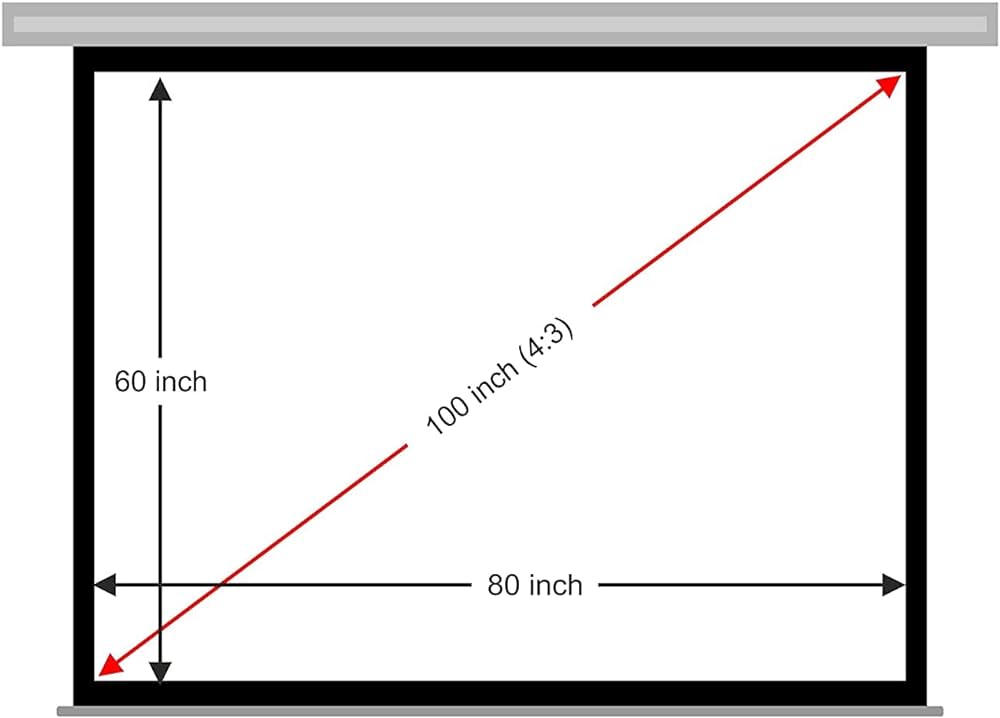Gigantic Projections: What is the Biggest Projector Screen Size?
Introduction
When it comes to projecting visual media, bigger is usually better. The bigger the screen, the more immersive the experience. Projectors offer the opportunity to project onto a variety of surfaces, but what is the biggest projector screen size you could go for? This article will explore the size of projector screens, explain what constitutes a projector screen size, explore common sizes and their uses, and delve into the largest projector screen sizes available in the market.
What Constitutes a Projector Screen Size?
The measurement of a projector screen size is not a straightforward length or width – but more! The key factor in determining projector screen size is its diagonal measurement in inches. This measurement is ascertained from one corner of the screen diagonally across to its opposite corner.
Here are critical elements involved in defining projector screen size:
- Diagonal Measurement: Simple yet essential, this is the straight-line distance running from one corner of the screen to its opposite corner.
- Aspect Ratio: This element influences the shape of the projected image. It is the ratio of the image's width to its height. The standard aspect ratios are 4:3 (standard TV), 16:9 (widescreen HDTV), and 2.35:1 (cinemascope films)
- Projection Distance & Throw Ratio: The throw ratio of a projector is the distance from the projector to the screen relative to the image's width. The size of a projector screen is often determined through this correlation.
- Space Constraints: The choice of projector screen size is also inevitably influenced by the room's size.
In summary, a projector screen's size is measured diagonally but is influenced by projected image's aspect ratio, the device's throw ratio, and the room's size. Carefully considering these factors ensures the screen size perfectly suits both the projector and the viewing space.
What Are Common Projector Screen Sizes and Their Uses?
Projector screens commonly available in the market can be broadly classified based on their sizes. These sizes are measured diagonally in inches, from one corner to the opposite diagonal corner. Here is a closer look at some of the commonly available screen sizes and their potential uses:
- 80-inch screens: Ideal for smaller spaces such as bedrooms or small conference rooms. These screens are perfect for one-on-one presentations or personal viewing experiences like gaming or movies.
- 100-inch screens: Offering a balance between size and space requirement, these screens are suitable for larger rooms or small home theaters. They deliver an immersive viewing experience, making them ideal for movie nights or bigger business presentations.
- 120-inch screens: This size offers a home theatre-like experience, being perfect for larger living spaces. They are suitable for a range of uses including hosting sports event viewings, delivering lectures, or movie streaming.
- 150-inch screens: These screens are typically reserved for larger home theaters or commercial theater use. They can create a truly cinematic and immersive viewing experience for movie buffs and are also great for commercial venues hosting events like concerts or workshops.
To summarize, the screen size you choose should ideally depend on the size of the room, viewing distance, utility, and of course, personal preference. Remember, a larger screen does not always guarantee a better viewing experience, especially if the room size does not support it. Also, the larger the screen, the higher the projector's light output needs to be for a clear and detailed image. Therefore, make sure you strike a balance between screen size, projector capability, room dimensions, and utility to guarantee an optimal viewing experience.
Exploring the Extreme: What is the Biggest Projector Screen Size?
The variance in projector screen sizes is astonishing, stretching from a modest 80 inches to an eye-popping 300 inches for consumer purposes. Meanwhile, the epitome of projection screen size marvel is witnessed at the IMAX in Darling Harbour, Sydney. This colossal structure holds the title for the world's largest fixed projection screen, measuring an enormous 117 feet in width and 97 feet in height.
When we specifically focus on commercially available projector screens, they usually max out at around 300 inches. Here's a breakdown of this whopper:
- Size: A 300-inch screen, measured diagonally, would approximate a width of approximately 262 inches and a height of around 147 inches, assuming a standard 16:9 aspect ratio. This immense size surpasses multiple average flat-screen TVs combined!
- Requirements: To effectively use such a gigantic screen, you'll need a projector capable of outputting exceptionally high light and resolution. Precisely, this allows the projected image to remain clear and vivid, even at such a large size.
- Suitability: A 300-inch screen is perfect for commercial venues or large outdoor events. It can create a cinematic experience that's incredibly immersive, primarily due to its sheer size. But remember, you must also have a suitably large space to accommodate it.
- Viewing distance: For an image projected on a screen of this size, the recommended viewing distance would be around 33-50 feet, as per the standards recommended by the Society of Motion Picture & Television Engineers (SMPTE).
In conclusion, when it comes to the largest commercially available projector screen size, 300 inches is the benchmark. This giant screen demands a praiseworthy projector and an appropriately spacious room to offer an unsurpassed viewing experience. However, careful planning regarding viewing distance and room dynamics is essential to ensure the best possible presentation.
Why Would You Choose the Biggest Projector Screen, and Where to Use it?
Opting for the largest projector screen undoubtedly has its perks, but it also demands specific accommodations due to its size.
Key Rewards:
• Immersive Experience - Large screens envelop viewers' field of vision, making them feel part of the unfolding story, game, or presentation.
• Enhanced Visibility - Bigger screens enable crisp, clear images from a greater distance, which is beneficial for large audiences.
• Improved Accessibility - Their size ensures that everyone, even those at the back, can clearly see the content without strain.
Ideal Situations:
• Large Auditoriums: Commercial theatres or spacious auditoriums are perfect for these massive screens.
• Outdoor Events: Alfresco film or sports event hosting becomes a memorable experience with large projector screens.
Nonetheless, it's crucial to remember that to employ such enormous screens effectively, you must have a spacious venue to allow sufficient viewing distance and prevent any image distortions. Additionally, the projector should have high light-output and resolution capabilities to maintain image quality over such vast projection areas.
In summary, while large projector screens offer unparalleled viewing experiences, they're only viable in locations that can handle their size and have the equipment to support quality projections on them.
How Do You Select the Appropriate Projector Screen Size?
Choosing the perfect projector screen size is influenced by multiple aspects. Let's break down these factors into digestible points to help you make an informed decision:
1. Space Availability: The size of your room will be a primary determining factor. A larger room can accommodate a larger screen, while smaller rooms may require a smaller screen to avoid visual impairment.
2. Viewing Distance: The Society of Motion Picture and Television Engineers (SMPTE) recommends that the optimal viewing distance should be between 1.5 to 2 times the width of the screen. So, take a moment to measure your room and calculate this distance before purchasing.
3. Projector Specifications: The capabilities of your projector are paramount. Ensure that your projector can efficiently handle the screen size you're considering. Most importantly, the larger the screen size, the more light output required from the projector.
4. Budget Constraints: Larger screens generally come with a heavier price tag, hence, consider your budget before making a decision.
Utilizing these factors as your guiding points will lead you to an informed selection of the most suitable projector screen size for your space.
Remember, while the sizes of projector screens vary greatly, with the largest ones providing an unparalleled viewing experience, it is essential to choose a size that best aligns with your specific needs, space availability, and budget constraints. The biggest screen is not always the best option, as every setup has unique requirements.
Conclusion
In conclusion, projector screen sizes vary widely, with the biggest sizes offering an unmatched, immersive viewing experience. However, choosing the right size should also consider factors like the viewing distance, room size, and projector capability. While it is tempting to go for the biggest projector screen size, it's crucial to choose what best suits your specific requirements and setup.
Related FAQs about what is the biggest projector screen size
Can you customize the size of a projector screen?
Yes, you can customize the size of your projector screen. Several companies provide customizable options based on your room's size and purpose. Always ensure your projector's specifications match the screen size for the best viewing experience.

Are there specific projectors for the biggest screens?
Yes, for larger screens, you need projectors capable of outputting higher light and resolution. Such screens typically require high-performance projectors to maintain the image's clarity and detail over the significant projection area.
How does the aspect ratio affect the projector screen size?
The aspect ratio impacts the shape of the projected image. It is the ratio of the image's width to its height. The aspect ratio selected has a significant effect on the projector screen size as it alters the image's proportions.


